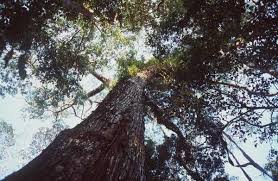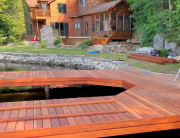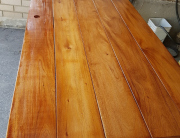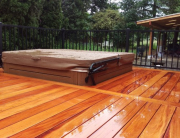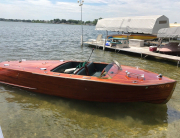History of Genuine Mahogany
Mahogany is a type of wood that is simply described as having straight-grains and a reddish-brown hue of timber. One of the first places Mahogany wood was discovered was in Belize, however it soon became known that the Mahogany tree was indigenous to the Americas. (Bridgewater, 2012) In its native environment, the Mahogany tree grows to an immense size – as much as 150 feet high and between 10 and 12 feet in diameter. The average Mahogany tree is 3 to 6 feet in diameter. In the wild before the 1900s there was no such thing as a purely mahogany forest – the trees generally grow scattered. In the jungles where they grow natively you will see proud but solitary crowns, here and there, being lifted above the trees’ lesser neighbours. Today there exists mahogany plantations in places like Fiji, where the density of mahogany trees is far above that which occurs naturally and does so in patterns that suggest their purposeful origins.
Although the exact origins of the word ‘mahogany’ are unverifiable, it has been largely speculated that it could have come from the native people’s dialect in the region where it was grown. In this usage it would have been a noun to describe the tree by the native Mayans. This noun was transformed into an adjective by Spanish explorers at some point. This might be the origins of the word mahogany, but there is another largely speculated theory concerning the slaves who were transported from Africa to America by European explorers. West Africans belonging to the Yoruba and Ibo peoples used the word ‘m’oganwo’ to describe the Khaya genus trees which grew natively in their homeland. The Khaya genus is a similar family to the American mahogany trees that the imported slaves would have seen upon their commission to the new world. So the adaption of their native word would have likely been in use by the explorers, making this theory very difficult to dispute. Yet we do not know the words that would have been used by other native peoples in the natural ecosystems of the Mahogany tree. Regardless of its precise origins into common vernacular, it is undisputable that the word ‘mahogany’ was in used widely enough to be included in works by London publisher John Ogilby for the first time in 1671. This is even before most of the major work had been done by botanists to properly classify and understand the types of trees that had been labelled with this word and all the connotations that arise from it.
Just as the oak can be distinguished from the hickory tree in temperate zone forests, the Mahogany tree has characteristics which distinguish it from other tropical hardwood trees. If you encounter one, you will see that is has a long, clean trunk, which sometimes extends 60 to 80 feet upwards before the tree’s first limb. The next thing you will see is its gray-brown bark, which is fairly smooth for the most part and grows in ridges or large individual scales.
The leaf of the Mahogany tree is compound, resembling that of the American ash or hickory. The flower is very small, yellowish red, and tulip-shaped. The seed grow inside of a large woody capsule that grows upright, not pendant, from the branch up to 5 or 6 inches in length. Within the capsule the flat, winged seeds are packed tightly in either 4 or 5 parallel double rows lengthwise of the container. Strangely enough, these seeds are the mellow golden brown colour of well-aged Mahogany!
Mahogany grows only in fairly specific climate zones, which includes the West Indies, particularly Cuba, Santo Domingo, and Jamaica, with small quantities of the same varieties occurring in the southern tip of Florida. On the American continent, Mahogany ranges from southern Mexico, northern Guatemala, and British Honduras, through Central America to northern Columbia and Venezuela. (Chaloner & Fleming; Mahogany & Timber Brokers, 1850) Since then, Mahogany has been found on the rivers tributary to the upper Amazon in Brazil and Peru. African mahogany is produced on the Ivory Coast, the Gold Coast, and in Nigeria. This type of Mahogany is found in West Africa and in certain parts of East Africa. Woods alleged to be Mahogany, but coming from other than these listed regions, are not genuine Mahogany. The rarity of the Mahogany tree lead to a great undertaking to ensure that it was one of the species cultivated in lands beyond its home. Shortly after WWII mahogany seeds were planted on the island of Fiji – and this is now the largest mahogany plantation in the world to date.
Although the Mahogany tree has been known to Europeans since shortly after the discovery of the American continent, it was not botanically classified until after 1760 when it was named Swietenia by Nicholas Joseph Jacquin of Leyden, who did this in honour of the Baron Geraard Von Swieten, botanist and physician from the same city. In 1762, the Mahogany trees of Central America were classified as a single species and designated Swietenia mahagoni by Carl Linnaeus, the founder of modern botany. (Lamb G. N., 1943) In 1886, the principal Mahogany form the mainland of Central America was described as Swietenia macrophylla by George King, who at the time was the superintendent of the British Royal Botanic Garden, after studying specimens from Honduras.
Genus is a term used in biology to describe relationships between several organisms that share enough similarities to be part of the same family, but are still distinct species. The scientific name for a genus is often called the generic name for the species. The Mahogany tree discovered in the Americas was given the genus Swietenia. Only this genus are classified officially as ‘genuine mahogany, while other related mahogany species have taken to be classified as ‘true mahogany.’ (Mell, 1917) Mahogany from Central America, scientifically known as Swietenia macrophylla, become generally known as Honduran or big-leaf mahogany, despite having a range from Mexico to the southern tributaries of the Amazon Rainforest in Brazil. Mahogany ranging from the Caribbean to the southern tip of the Floridian peninsula, scientifically known as Swietenia mahagoni, became known as West Indian, or Cuban, mahogany. This species was initially dominant in the trade of mahogany lumber. As harvesting intensified will European transportation routes passing through the Americas more frequently, Mahogany trees were constantly being sought out by botanists, commercial exporters, and industrialists.
Long after it had been discovered in America, a Mahogany variant was also found on the west coast of Africa. This African Mahogany was first classified as Swietenia senegalensis. In 1830, Jussieu Desrousseaux then differentiated geographically between the American and African species, proposing that the latter be classified as Khaya senegalensis. As time went on, several species of the genus Khaya were reorganized – the most plentiful being Khaya ivorensis. The distinctions between African and Central American Mahoganies only grew as examination of the living tree and wood it produces intensified.
From the beginning, Mahogany study and harvesting has been a long and difficult battle with the trackless tropical wilderness. Old-growth areas that contained mahogany had often been as-yet unmolested by human industry. Since in their natural environment the trees grow scattered, an average of only 2 per acre being considered a good stand, the challenge commences with a complete survey of the area to determine whether it contains enough Mahogany in valuable quantities and in conditions that permit getting it out. Today, however, genuine mahogany plantation exist where no destructive paths need to be cut into the landscape because the trees were planted with the foreknowledge of their eventual harvesting. These plantations most certainly exceed the natural density of Mahogany trees within a forest, yet the teeming ecosystems that thrive under their high canopies remain. While at first Mahogany near river banks was cut so transportation would not be a problem, today’s Mahogany hunter must go further into the jungle, forging main trails and then branch trails to each tree. Once a tree was felled, it was customary to entrust the prodigious task of hauling the logs over these trails, to cattle in the America, and in Africa to man power. Throughout the twentieth century, despite technological advances and the wide use of tractors, it was still often necessary to resort to men or oxen to pull logs from their paths. (Anderson, 2012) This practice continues at a rate representative of the size of the mahogany industry today because of the difficult natural terrain and the inherent destructiveness of large machinery on the ecosystem.
Cuban mahogany was in such widespread demand that it could not contest or abate the rate of its commercial consumption. It was desired in a seemingly-limitless number of applications, ranging from furniture, decking and instruments to patrol boats used in World War II. This species of Mahogany was used by Spanish explorers in the early 1500s to repair their seafaring vessels and construct canoes. These explorers quickly understood the value of the wood’s properties and it quickly became a desirable import in Spain. (Lamb, 1966) Fine pieces of cabinetry constructed from this timber marked the Spanish renaissance. Because tradition in England called for the use of domestic oak and walnut lumber in furniture, Cuban mahogany was not adopted as their preferred wooden medium until circa 1720. From then on Swietenia mahagoni was the choice of the royals, officials, elites, businesses, and really anyone who could afford it. Once adopted by the English, Cuban mahogany almost overnight became the most popular in France and Italy. (Aronson, 1967) By the early 1800s, furniture pieces made from this wood were even popular in the Americas. As industrialization gained momentum and began to undeniably and irreversibly change humanity’s means of production, it would not be a stretch to call the 18th and 19th centuries ‘the Age of Mahogany.’ This unquenchable need for Cuban mahogany ultimately lead to the demise of its commercial availability due to supply restrictions after World War II. The Mahogany tree is a unique species that warrants obvious protection because the same characteristics that bestow its legendary status also sentence it to a life of danger.
As Cuban mahogany slowly evaporated from the commercial marketplace due to price inflation caused by overharvesting and export restrictions, Honduran mahogany developed into the commercially dominant species on a global scale. It was so relatively common, that when many people simple refer to this species as ‘mahogany.’ Other than the name big-leaf mahogany, it also developed several common names including: genuine mahogany, broad-leaved mahogany, Brazilian mahogany, large-leaved mahogany, and tropical American mahogany. This type of wood become so prized as a primary material for use in a wide range of high durability and high complexity manufacturing processes, because of its inherent qualities. This widespread lust for the Mahogany tree has come to be known as the ‘romance of mahogany.’ Mahogany was used in furniture that aged timelessly and were definitively labeled ‘antiques.’ (Macquoid, 1906) Supplies of Honduran mahogany were mostly steady up to the turning point of the 20th century. All of the notable and classic lines of furniture produced in the 17th, 18th, and 19th centuries were produced and sometimes reproduced in beautiful genuine Mahogany. Mahogany panelling, cabinetry, musical instruments, and even boats embodied the attitude of the era and the spirit with which both the commercial and consumer marketplace viewed the genuine mahogany timber.
Military efforts during both World Wars (but mainly WWII) resulted in the depletion of vast quantities of mahogany, triggering supply constriction. As supplies dwindled, large segments of demand were being unmet under current market conditions. Illegal logging had always been something that existed since vigilantes had the means to transport felled logs from a remote area to some form of transportation. These vigilantes could be domestic peoples or extra-territorial plunderers, but for their illegal ventures to succeed they must be able to find a buyer that is not concerned with the source of its material. The supply constriction had the effect of causing industries heavily concentrated on production of Mahogany goods not used in war to be seeking any available source for the lumber they needed. At this time, certain industrialists began to vocalize the fact that genuine mahogany would be a viable plantation grown tree for centuries to come if not indefinitely.
Genuine Mahogany trees began to be grown in commercial and governmental plantations that would ultimately aim to provide a sustainable source of this unique wood for generations to come. Government economic philosophy combined with both commercial and botanical desires to establish plantations of tropical hardwood trees such as genuine Mahogany. But until plantations came to maturity, illegally-sourced lumber began making up large percentages of some countries’ Mahogany wood imports. Even the scattered, remote, but majestic Mahogany tree was no match for the pace of 20th and early 21st century industrialization.
The dangerous lives of Mahogany trees in this new world were ultimately threatening the special species’ chances of survival. Beginning in the early 20th century, commercial lumber plantation were beginning to be carved from what was originally large swaths of indigenous land that were now controlled by the local government. In many cases logging was unregulated and illegal logging seems to have taken an irreparable toll on the native habitat of genuine Mahogany. The directive that had spawned from botanical philosophy to protect the lineage of certain trees also ended up helping to have the species placed upon Appendix II of CITES (the Convention on International Trade in Endangered Species of Wild Fauna and Flora) in 2003. (White & Gasson, 2000) CITES is an international treaty designed to ensure that international trade does not endanger the survival of animal and plant species in the wild. Placement on Appendix II ensures restrictions are enforced that would prevent the species in question to enter a state where its extinction is looming. Allowing only plantation lumber exemption to CITES’ restrictions ensure that the Mahogany tree will still be visible in some of its native territory and that plantations may allow the continued enjoyment of the timber it supplies.
The visual beauty on the face of genuine Mahogany became a tradition, and so for most people it is the most familiar characteristic of the wood. To wood technologists, however, wood is a matter of pores, grain, figure, and colour. To a builder of wood furniture and other wooden utilities, it is a matter of physical properties. In all, Mahogany shows superior characteristics. For example, when you look at the end surface of mahogany the pores show up even to the naked eye as tiny dots or pin pricks. On more or less longitudinal surfaces, these pores appear as fine pen lines, dashes or dots, according as the cut is with the grain or slightly across it. Although uniformly scattered, the pores vary somewhat in size and some of them appear to contain a dark glistening substance.
Looking again at the end section, you will see that Swietenia Mahogany displays concentric growth lines while African mahogany does not. Running from the center of the tree to the circumference, basically parallel, and about the thickness of a pore apart, are the fine ribbon-like bands of tissue than make the inconspicuous “flake” or “sycamore grain” that shows when the wood is cut on the radius, or quartered.
To produce a tangential surface, the log must be cut at right angles to the radius. On such a surface, the pores show as long and irregularly parallel lines with numerous very short fine dashes appearing between them when observing the wood under a magnifying glass. These are the end views of the pith rays. In American Mahogany they are staggered.
Mahogany is less liable to warping, shrinking, swelling, and twisting than other woods. This is because of its unusual resistance to moisture and atmospheric changes. Mahogany does not move – it holds its shape. Because of the size of the Mahogany tree, it produces incredibly clear large pieces.
Although most people may recognize the distinctive figure of Mahogany – its crotches, swirls, and stripes – often observed on table tops, the majority of trees do not run to figure. In fact, most Mahogany logs are comparatively straight-grained. This is much more suitable for structural applications. Additionally, Mahogany logs are distinguished by a total absence of the alternate rings of dense and less dense wood which characterizes many other woods. This results in a unique uniformity of texture, which not only contributes to the wood’s strength, but is a decisive factor in the speed, ease, and success of gluing, machining and other manufacturing processes necessary in construction. In the efficiency with which it can be mortised, bored, shaped, and turned, Mahogany has been given the highest rating amount all woods which might be available.
Mahogany is particularly resistant to rot, mold, and pother organisms of decay, both with respect to the atmosphere and with the soil. This makes it an excellent wood for any use in tropics, where these conditions are a constant hazard. In addition, it is almost completely immune to then furniture beetle, which frequently known to destroy other woods, and is likewise highly resistant to the attack of drywood termites.
Mahogany’s structure present advantages in the finishing process as well. In fact, once the wood is cut from the log, it can be properly kiln dried in a minimum time without wastage. Mahogany from Central America shows extremely low overall shrinkage with regards to volume and dimensions during the drying, but what truly makes it the best for keeping shape is the close to 1:1 ratio of radial (measured in the direction between the center of the tree and the bark) to tangential (measured in the direction of the circumference) shrinkage. This scientific ratio is the determining factor in woods’ resistance to warping and splitting. The wood has a natural affinity for modern finishes, compounding further advantages as the finish seals the wood in order to further unsure its resistance to moisture and temperature changes. In this respect, Mahogany is outstanding – its texture takes and holds finishes unusually well.
Mahogany’s inherent physical properties have made it the favourite wood of cabinet-makers and other master craftsmen for five centuries. Mahogany is exceptionally strong for its weight, outranking any of the woods that could possibly substitute it as a medium weight wood in structural applications.
Special thanks to these inspirational books & papers:
Anderson, J. L. (2012). Mahogany: The Costs of Luxury in Early America. Boston: Harvard University Press.
Aronson, J. (1967). The New Encyclopedia of Furniture. New York: Crown Publishers.
Bridgewater, S. (2012). A Natural History of Belize: Inside the Maya Forest. Edinburgh, United Kingdom: University of Texas Press.
Chaloner & Fleming; Mahogany & Timber Brokers. (1850). The Mahogany Tree: Its Botanical Character, Qualities and Uses. Liverpool: Rockliff and Son.
Lamb, F. B. (1966). Mahogany of Tropical America: Its Ecology and Management. Ann Arbor: University of Michigan Press.
Lamb, G. N. (1943). The Mahogany Book. Chicago: The Mahogany Association, Inc.
Macquoid, P. (1906). A History of English Furniture: The Age of Mahogany. New York: Dover Publications.
Mell, C. D. (1917). Bulletin No. 474: True Mahogany. Washington: U.S. Dept. of Agriculture.
White, L., & Gasson, P. (2000). Mahogany. Richmond, Surrey, United Kingdom: Royal Botanic Gardens, Kew.
Fijian Mahogany decking is available through Green World Lumber
